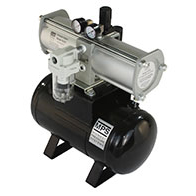Air Pressure Booster Systems
What design standards are met?
System receiver tanks have an ASME U stamp and CRN number. Boosters are designed with a minimum 4:1 safety factor.
How do I control discharge pressure?
The booster comes with a built-in pressure regulator to adjust the maximum discharge pressure. During operation the booster will provide a discharge pressure that is typically 2-10% lower than the maximum discharge pressure. It is important to note that if the flow rate varies the discharge pressure will also vary. To maintain a constant discharge pressure, MPS recommends a tank mounted system with an additional discharge pressure regulator.
What is the difference between operational discharge pressure and the maximum discharge pressure?
The operational discharge pressure is the discharge pressure the booster produces while providing the desired flow rate. This pressure is lower than the maximum discharge pressure. As the booster approaches its maximum discharge pressure, it begins to slow down and the flowrate decreases. At the maximum discharge pressure it stops cycling because all of the forces in the booster are balanced. When a booster fills a tank, it stops automatically when it reaches the maximum discharge pressure. It restarts automatically when the pressure in the tank drops.
How do I control flowrate?
The booster automatically adjusts its cycle rate to match the desired flowrate. No additional flow controls are required.
What is the operating life of an air booster system?
Air boosters are designed for 20 million cycles. The flowrate and supply pressure must be known to determine the life in hours. For example, with a supply pressure of 80 psi Model R03S will have an operating life of 12000 hours at a flowrate of 10 scfm and 6000 hours at a flowrate of 20 scfm. They can operate 24 hours a day, seven days a week.
What drive air quality is required?
Most boosters in an indoor factory environment operate problem-free on shop air with a +40• F pressure dewpoint and particulate filtration of 5• or better.
How much air is used to drive the booster?
Drive air consumption is approximately 1/2 to 1 times the amount of pressure-boosted air depending on the pressure boost ratio. For example, if 10 scfm of high pressure air is required, the Bootstrap Compressor will need 15-20 scfm of shop air, and 5-10 scfm of that air will be vented through an exhaust silencer.
What are the determinants for selecting the right system?
These common determinants help us identify the right system to meet your needs.
- Air quality
- Supply pressure
- Discharge pressure
- Flowrate
- Continual usage vs. intermittent usage
Consult our engineering team with these determinants to select the right system.
Is there a way to tell when maintenance is required?
Maintenance is required when:
- The booster is leaking or not building pressure
- The booster is not cycling
Why do boosters fail?
The most common causes of booster failure are:
- Particulate contamination causing a jammed control valve
- Dynamic seals are worn out
MPS offers rebuild kits and rebuild services. Please call us to get a return authorization number and then we will analyze and quote the repair upon receipt. Quotes for all repairs are at no charge.
Is there a way to reduce downtime when a booster system needs maintenance?
Many customers keep a spare booster in stock. They depressurize the booster system, remove the worn out booster, and install the new booster.
Redundant booster systems are also available. A redundant booster system has a spare booster (or boosters) incorporated into the system. Valves are provided so that one booster can be completely isolated and safely removed from the system while the second booster is operating. This eliminates any downtime due to maintenance requirements.
What are the common applications for air pressure booster systems?
Here are some of the more common uses:
- Leak detection
- Pressure testing
- Increase pressure to air drying
- Increase pressure to nitrogen generators
- High pressure tire filling
- Increase force from pneumatic valve actuators
- Increase force from pneumatic cylinders
- Increase force from pneumatic presses
- Maintain pressure on inkjet printers for labeling
- Increase holding power of pneumatic chucks
- Increase pressure for products packaging
- Increase force for pigging paint and syrup lines
- Increase pressure on sandblasting equipment
- Increase force of pneumatic springs
- Increase force of pneumatic lift tables
- Increase force of pneumatic shears
- Railroad brake testing
- Unloading railroad cars using pressure
- Shield gas for plasma and laser cutters
- Increase pressure from pneumatic gas boosters
- Increase pressure from pneumatic piston pumps
- Increase pressure from pneumatic diaphragm pumps
- Increase force from ejection pins on plastic molds
- Blow Molding
View more products:
Air Pressure Booster Systems
• Gas Pressure Booster Systems
• Electric Inert Gas Pressure Booster Systems
• Repair Parts & Kits
• High Pressure Tanks


